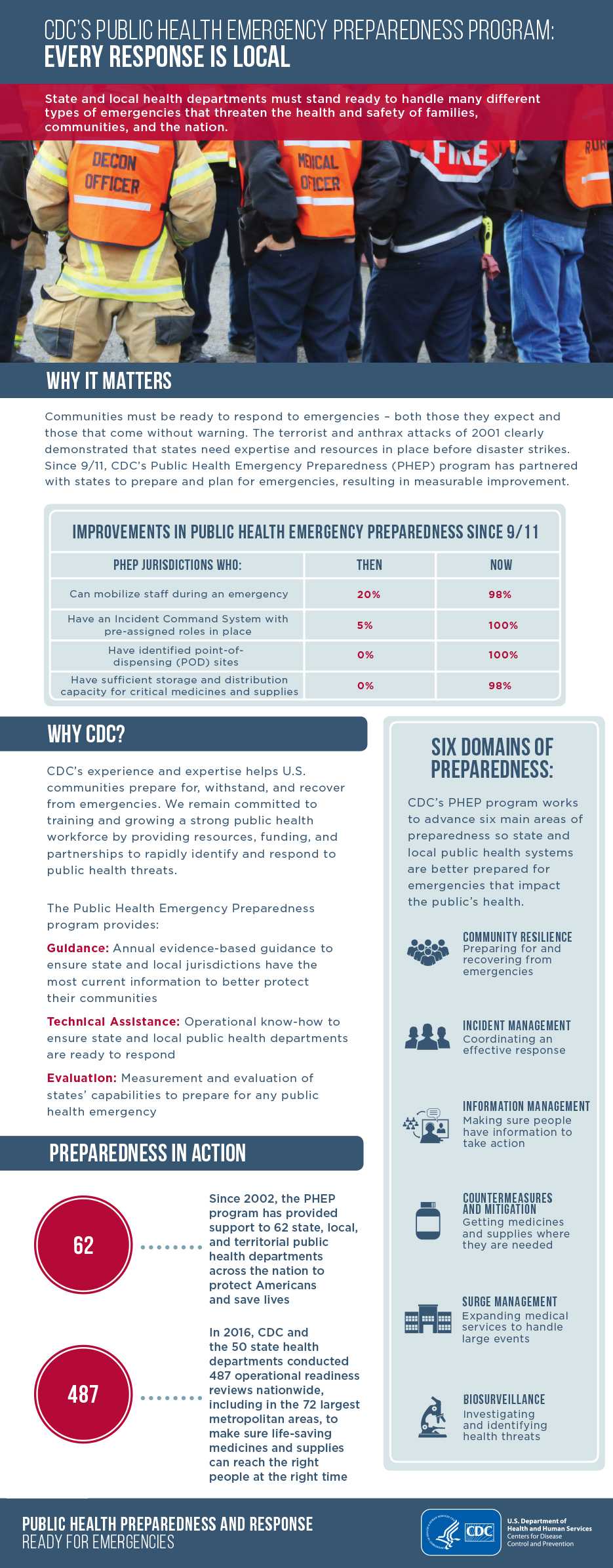CDC’s Public Health Emergency Preparedness Program: Every Response is Local
Text Equivalent
CDC’s Public Health Emergency Preparedness Program: Every Response is Local
State and local health departments must stand ready to handle many different types of emergencies that threaten the health and safety of families, communities, and the nation.
Why It Matters
Communities must be ready to respond to emergencies – both those they expect and those that come without warning. The terrorist and anthrax attacks of 2001 clearly demonstrated that states need expertise and resources in place before disaster strikes. Since 9/11, CDC’s Public Health Emergency Preparedness (PHEP) program has partnered with states to prepare and plan for emergencies, resulting in measurable improvement.
Improvements in Public Health Emergency Preparedness Since 9/11
| PHEP JURISDICTIONS WHO: | Then | Now |
|---|---|---|
| Can mobilize staff during an emergency | 20% | 98% |
| Have an Incident Command System with pre-assigned roles in place | 5% | 100% |
| Have identified point-of-dispensing (POD) sites | 0% | 100% |
| Have sufficient storage and distribution capacity for critical medicines and supplies | 0% | 98% |
Why CDC?
CDC’s experience and expertise helps U.S. communities prepare for, withstand, and recover from emergencies. We remain committed to training and growing a strong public health workforce by providing resources, funding, and partnerships to rapidly identify and respond to public health threats.
The Public Health Emergency Preparedness program provides:
- Guidance: Annual evidence-based guidance to ensure state and local jurisdictions have the most current information to better protect their communities
- Technical Assistance: Operational know-how to ensure state and local public health departments are ready to respond
- Evaluation: Measurement and evaluation of states’ capabilities to prepare for any public health emergency
Preparedness in Action
- Since 2002, the PHEP program has provided support to 62 state, local, and territorial public health departments across the nation to protect Americans and save lives
- In 2016, CDC and the 50 state health departments conducted 487 operational readiness reviews nationwide, including in the 72 largest metropolitan areas, to make sure life-saving medicines and supplies can reach the right people at the right time
Six Domains of Preparedness:
CDC’s PHEP Program works to advance six main areas of preparedness so state and local public health systems are better prepared for emergencies that impact the public’s health.
- Community Resilience: Preparing for and recovering from emergencies
- Incident management: Coordinating an effective response
- Information Management: Making sure people have information to take action
- Countermeasures and Mitigation: Getting medicines and supplies where they are needed
- Surge Management: Expanding medical services to handle large events
- Biosurveillance: Investigating and identifying health threats
- Page last reviewed: February 6, 2017
- Page last updated: February 6, 2017
- Content source:


 ShareCompartir
ShareCompartir
